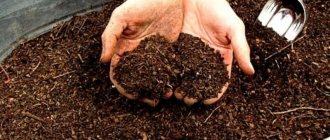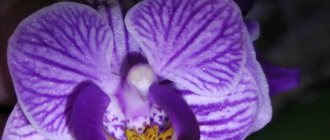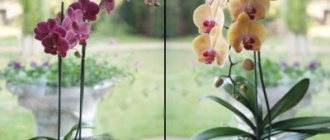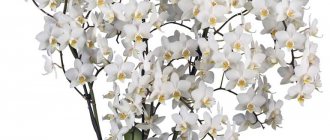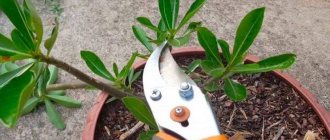At home
If you look at thematic forums, information about the timing of growth at home varies. Some write that the plant died after 3 years, others enjoy the sight for more than 10 years. Life expectancy directly depends on the created growing conditions.
Dependence of the duration of existence on the variety
Variety is one of the important indicators. For example, phalaenopsis can live for about 7-10 years, but dendrobium can live for a maximum of 6 years. If we consider Cattleya, then this variety is unpredictable and its lifespan directly depends on care.
How to determine the age of an orchid?
To make it live longer, you need to buy a young plant. It is better to go to a specialized store for this. Determining the age of an orchid is quite difficult. There is a popular opinion that the age of a flower can be determined by the number of leaf blades, but this is not entirely accurate. If a flower receives fertilizer in excess, the young plant may also have a lot of leaf mass. Young plants usually have a short trunk. The absence of flowering indicates the youth of the plant. In addition, the adult flower will have marks from cut branches.
Orchids blooming
As you know, orchids bloom quite beautifully. However, sometimes it is difficult to achieve flowering, which is also often associated with the quality of maintenance and care.
Under natural conditions, orchids grow in a fairly aggressive environment, which is caused by a large number of different insects, fungi, and bacteria.
Features in natural conditions
The peculiarity of phalaenopsis is that they do not have a dormant period; they can bloom in the summer, when there is a dry spell outside. During this period of time, plants are pollinated by insects, and flowering persists for a long time. The main natural factor is the temperature difference.
Duration at home
Many gardeners are interested in the question of how long orchids bloom at home. As practice shows, this culture blooms throughout its entire life. The period largely depends on the conditions created and the selected variety.
Season
Orchids grown at home bloom mainly in winter:
- Phalaenopsis - December.
- Cymbidium – blooms from October to February.
- Dendrobium - from October until the very end of winter.
- Oncidium – April-July.
How many times a year
The number and duration of flowering directly depends on the quality of care and the conditions created for growth. If the care is high-quality, then throughout the year the flower can bloom 2 to 3 times. But to achieve this, you need to follow the watering regime, temperature regime, humidity level, and use a substrate for orchids.
What determines the duration of flowering
Each individual flower can bloom for 3 to 4 weeks. The duration largely depends on the level of humidity, temperature, and the condition of the plant. It is not recommended to apply fertilizers and fertilizing during the flowering period.
How many times can an orchid bloom on one peduncle?
The number of blooms depends on the type and variety. For example, in some hybrids it is genetically determined that the peduncle dries out after flowering. In other varieties, it’s the other way around – the young ones almost wake up, giving new shoots.
How to renew
If necessary, the flowering period can be extended. To do this, it is recommended to place the culture in a cool room in which the temperature will vary from +20 to +25 degrees.
Environmental influence
Any plant blooms in several cases:
- Favorable growing conditions have been created.
- The culture is on the verge of death and produces seeds to preserve its species.
In addition, flowering will not occur if you place the flower in a dark place - the sun is required.
Can the baby bloom?
In the event that the baby remained on the peduncle and was not removed, then it is likely that after 4 leaves appear it will bloom. In this case, nutrition is provided by the mother bush, which will not bloom on its own.
How to create optimal conditions?
In order for a plant to be healthy, it must have the right conditions for its existence. And he will make sure that it is not subject to pest invasion.
Ambient temperature and humidity
These are two factors that must be strictly followed. So, the temperature should be in the range of 23-27 degrees Celsius . Deviations towards cold threaten frostbite, and warming above 27 degrees can cause overheating of not only the leaves, but also the root system of the orchid.
Humidity also plays a significant role, especially at the moment when the plant needs to shoot out its flower shoot. At this moment, care must be taken to ensure that the air humidity in the room reaches 85%.
Humidity and temperature are the most important factors for an orchid.
The influence of proper watering
How long an orchid lives in a pot is most significantly influenced by a properly designed watering scheme:
- If watering is not adjusted and is given to the plant very rarely , then the roots will dry out for too long, and at this moment the velamen on them may collapse . As a result, the roots will gradually begin to die. And a small amount of root mass will not be able to feed the green vegetative part, and therefore the lower leaves of the bush will begin to die. In this case, there can be no talk of longevity;
- Gardeners consider overwatering the plant to be the second extreme. Due to frequent and abundant watering , the substrate becomes swamped and the roots stop breathing oxygen. After which they soften due to rot. And the plant is subject to resuscitation efforts to build up the root mass.
For flowering
Sometimes, with good care and the presence of residual hormones after growing in Dutch greenhouses, a flower can please its owner with three arrows . It should be noted that the flower after such flowering can be severely depleted.
To prevent this, when all the arrows bloom, we are surprised and admire the flowering, then we photograph it for history and cut out 1-2 peduncles. After this, the orchid blooms with the remaining flower shoots, and those that were cut off are placed in water, where they can stand and delight the grower for more than a month.
An orchid can stand in a vase for up to one month.
Rest period
After flowering or at high ambient temperatures, the plant begins a dormant period. It can last 1-3 months , during which the plant regains its strength. At this time, watering is done as needed, without allowing the substrate to dry out completely, but also without flooding the flower.
When the flower leaves the dormant stage, watering is increased and fertilizers are added to it twice a month.
IMPORTANT! Fertilize the orchid with a specialized fertilizer and only on wet roots, so as not to burn the velamen.
Stimulation of flowering and appearance of babies
need to be stimulated . Because stimulation inhibits the development of root mass and leaves. Therefore, by the time the grower decides to carry out stimulation, the orchid must be ready for it.
Only a completely healthy plant can be stimulated.
For young and old plants
There is no difference in care. The only difference is that if a young orchid is planted in a small container, it will dry out faster, so you will need to be more careful about watering. And replant it only when necessary, since after replanting the flower may become slightly sick.
Factors on which the lifespan of orchids depends
Ever since an exotic plant from the humid tropics migrated to a pot with a special substrate, beauty connoisseurs are trying with all their might to extend its life. Judging by the opinion of experienced flower growers, several factors can be identified that influence the life expectancy of these wonderful flowers. The leading role is given to the type of plant and the atmosphere in which it is located.
In fact, it is difficult to say how long orchids live; in some cases it depends on what types of hybrids took part in crossing and breeding a new variety. Although there is no clear answer to this question, practice shows that on average this period lasts about 5 years.
Step-by-step instructions on how to rejuvenate an old plant
The method of rejuvenating a Phalaenopsis orchid is simple. You don't have to remove it from the pot to do this. We'll tell you how to update an old orchid.
- Preparing the cutting tool. It is better to take garden pruners rather than scissors with a sharp blade. Before the procedure, treat the instrument using an alcohol solution.
- Trimming. Taking a pruning shear in your hands, cut off the top with aerial roots, moving from the bottom of the stem.
The lower part and part of the stem are left in the old pot. Over time, the children will move away from the stump at the roots. Note! When cutting off the top, they try to separate the largest number of roots from it. The orchid tolerates the procedure more easily if you cut off the top with 6-10 roots, rather than 3-5. - Treatment of cut areas. When processing cut areas on the top or stump, use wax, garden pitch or paraffin. Before returning the flower pot to its place, wait until it dries.
If the roots stick up and do not fit in the pot, soak them in water. After this procedure, they will become more elastic and fit into the pot as they should. If leaves interfere with this, cut them off, exposing the neck.
Watch a video on how to rejuvenate a Phalaenopsis orchid:
Flowering period and lifespan - what is the difference?
Many people confuse these two concepts, mistakenly believing that the flowering cycle and lifespan are the same thing. To understand the difference, you need to familiarize yourself with what each definition means.
The flowering period is the period during which the orchid's inflorescences appear and fade. It can last for six months, but in most cases it is limited to 2-3 months. During this period, the plant sends out an arrow on which flowers form, and after some time they fade - the duration of flowering depends on the variety and conditions of detention.
Pests and diseases
This factor, which influences how many years an orchid lives, is based on proper care and living conditions.
- Scale insects. Dangerous pests that greatly shorten the life of the leaf blade and flower stem. This, naturally, has a detrimental effect on the overall immunity of the orchid, shortening its life.
- Spider mite. It is also dangerous for the leaf, greatly reducing its nutrient accumulation. A white coating appears on the leaf plate. This means that without treatment, the plant's days are numbered.
- Rotten. A type of disease, the occurrence of which greatly shortens the lifespan of orchids. The main reason for their occurrence is high humidity and excessive soil moisture.
So, according to botanists and gardeners, modern domesticated orchids live an average of 5 years. But proper care, organized in accordance with the species and individual aspects of the pet, can significantly extend this period.
In what cases do orchids need replanting?
There is no need to immediately replant a flower purchased in a store. For orchids, such manipulations cause stress, so knowledgeable gardeners resort to them only in extreme cases. They are given below:
- It happens that the leaves of a plant grow to one side and tilt the pot. In this case, along with replanting, you also need to make the container heavier to create balance.
- It is necessary to transfer the orchid to a new pot if there is sphagnum moss in the old one.
- If there are diseased roots through the walls of the transparent pot, then you need to remove the plant, trim it and plant it in another container.
- When after the manipulation there are too few roots left, then part of the bush along with the peduncle should be removed. This is done in order to provide the orchid with normal nutrition.
- The instability of the flower also serves as a signal to change the container and add substrate.
Transplants should be approached with balance. Do not delay this procedure for a long time, since in depleted soil the flower will gradually begin to fade.
How long does Phalaenopsis live?
When growing at home
Each variety of phalaenopsis has its own terms of development and flowering; the average standard, with proper care, will delight its owner for 6-7 years. Dendrobium is not so durable; its life on your windowsill will last 4 years maximum.
Proper care of an orchid prolongs its life.
Such data were released by experts after conducting a series of studies and some experimental tests.
Important! This lifespan will only be available for those trunks whose care is ideal. But all this is conditional; there is information that some plants significantly exceeded the permissible values
But all this is conditional; there is information that some plants significantly exceeded the permissible values.
This is evidenced by photos on the Internet and stories from the flower growers themselves.
The rating of long-lived orchids looks like this:
- At the top of the list is Paphiopedilum, which is already more than 150 years old;
- The dendrobium, which lived on the windowsill of one grower for a little over 20 years, will not catch up with it;
- The callathea orchid follows, its development and growth continued in the same pot for almost 18 years;
- Maxillaria is a little behind them; it has delighted its owners for 13 years.
Important! According to flower growers who own long-lived orchids, this lifespan was facilitated by strict adherence to all standards of care, moderate watering and, of course, the love of the owners themselves
In nature
According to studies, phalaenopsis live quite a long time in natural conditions; some varieties can actively develop for several decades.
Science knows of centenarians that have grown in the wild for more than two hundred years.
The main cause of death for the phalaenopsis orchid in nature is loss of support; the trunk dies due to the death of the tree, movement or crushing of stones.
But there are other reasons, including:
- Climate change (sharp cooling, extreme heat without rain);
- Fungal or viral diseases;
- Pest invasion.
In the wild, there is little stopping an orchid from developing.
But this does not prevent orchids from actively growing and developing; there are a lot of them in the wild.
Where does the peduncle of an orchid appear?
How does an orchid's peduncle
?
We must remember that the peduncle
from the axil of the plant leaf. Sometimes it comes out from the growth point. All other shoots emerging from the stem and other parts (root areas) can be roots or children.
Interesting materials:
How to properly install plywood on a wooden floor? How to use a hydrometer correctly? How to use a Neva gas water heater correctly? How to use a gas stove correctly? How to use a hot smoked smoker correctly? How to use a fir broom correctly? How to use salt lamps correctly? How to use an impact screwdriver correctly? How to use green soap correctly? How to properly clean a pool?




